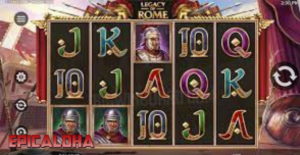UNVEILING THE ENIGMATIC SYMBOLS OF ANCIENT ROME DELUXE
The symbols of ancient Rome hold a captivating allure, each emblem carrying a rich history and profound meaning. Understanding these symbols provides a fascinating glimpse into the beliefs and values of this legendary civilization.
In this blog post, we will delve into the significance of ancient Roman symbols, unraveling their hidden meanings and exploring why they continue to intrigue and inspire us today. From the iconic eagle to the formidable laurel wreath, each symbol tells a story of power, legacy, and cultural pride.
Join us on a journey through the deluxe world of ancient Roman symbols as we unlock the secrets behind these timeless icons. Discover the deeper layers of meaning behind these symbols and unveil the mysteries that have captivated historians and scholars for centuries.

IMPORTANCE OF SYMBOLS IN ANCIENT ROME
Symbols held immense importance in ancient Roman society, representing deeper meanings beyond their visual appearance. Let’s delve into the cultural and historical significance of symbols in ancient Rome and explore how they were integral to various aspects of life.
RELIGIOUS SYMBOLS
Religious symbols played a pivotal role in ancient Roman spiritual practices, embodying beliefs and values of Roman deities. The eagle symbolized Jupiter, the king of gods, while the she-wolf represented the nurturing nature of Lupa, the legendary mother of Rome. These symbols were not only decorative but also served as a way to connect with the divine forces.
POLITICAL SYMBOLS
In the political realm, symbols were wielded as tools of authority and affiliation. The fasces, a bundle of rods around an axe, symbolized the power of magistrates to enforce Roman laws. The laurel wreath was a symbol of victory and honor, often worn by conquering generals and emperors. These symbols conveyed messages of power and status, shaping political identities and governance structures in ancient Rome.
Symbols in ancient Rome were more than mere decorations; they were a language of their own, communicating values, identities, and beliefs across various aspects of society. By understanding the meanings behind these symbols, we unravel the rich tapestry of ancient Roman culture and its intricate use of visual language.
COMMON SYMBOLS IN ANCIENT ROMAN CULTURE
Ancient Rome was rich with symbolism that reflected its values, beliefs, and aspirations. Let’s explore some of the common symbols that were deeply ingrained in Roman culture
The eagle was a prominent symbol in ancient Rome, representing power, strength, and sovereignty. In Roman mythology, the eagle was associated with Jupiter, the king of the gods, symbolizing protection and divine authority. Romans believed that the eagle was a messenger between the earthly realm and the divine world, emphasizing the connection between gods and mortals.
In Roman military standards, known as aquilae, the golden eagle was a symbol of the Roman legion’s honor and loyalty to the empire. It served not only as a military insignia but also as a rallying point for soldiers on the battlefield. The eagle’s majestic presence instilled a sense of pride and unity among Roman troops, inspiring them to fight courageously for the glory of Rome.
SPQR, short for “Senatus Populusque Romanus” meaning “The Senate and People of Rome,” was a powerful symbol of the Roman Republic. It represented the collective authority of the Roman government, uniting the Senate and the citizens under one emblem. SPQR adorned public buildings, coins, and military standards, serving as a reminder of Rome’s republican values and civic duty.
Even after the transition from a republic to an empire, SPQR retained its significance as a symbol of Roman identity and patriotism. The phrase endured through the centuries, becoming synonymous with the eternal legacy of Roman civilization and the enduring spirit of its people. SPQR embodied the ideals of freedom, democracy, and the rule of law, making it a timeless emblem of Roman culture.
Explore the rich symbolism of ancient Rome to uncover the hidden meanings behind these iconic symbols that continue to captivate our imagination and reverence for one of the greatest civilizations in history.
SYMBOLISM IN ROMAN ART AND ARCHITECTURE
Symbols in Roman art and architecture serve as powerful representations of the beliefs, stories, and values cherished by the ancient Romans. Let’s delve into the fascinating world of Roman symbolism through their artistry and architectural marvels.
FRESCOES AND MOSAICS
Roman frescoes and mosaics were not merely decorative pieces but intricate storytelling devices. These vivid artworks adorned walls and floors, depicting scenes from mythological tales, historical events, and daily life. Frescoes, painted directly onto walls, showcased detailed narratives with symbols like gods, animals, and geometric patterns. Mosaics, composed of tiny colored tiles, portrayed similar stories with vibrant imagery, adding depth and color to Roman homes and public buildings. Each symbol woven into these artworks carried profound meanings, offering a window into Roman culture and beliefs.
ARCHITECTURAL ELEMENTS
Roman architecture stands as a testament to the empire’s grandeur and sophistication, incorporating symbolic elements that transcended mere aesthetics. Columns, integral to Roman buildings, symbolized strength and stability, with different styles denoting various virtues like wisdom or victory. Statues, whether of emperors, gods, or heroes, represented idealized figures embodying Roman values and myths. Inscriptions on buildings conveyed messages of power, piety, or commemoration, adding layers of meaning to architectural structures. These elements not only served practical purposes but also communicated the beliefs and aspirations of Roman society, shaping the very landscape of their world.
CONCLUSION
In conclusion, the symbols of Ancient Rome Deluxe offer a captivating glimpse into the intricate tapestry of Roman culture and history. From the majestic eagle symbolizing power and authority to the iconic laurel wreath representing victory and honor, these symbols play a pivotal role in unraveling the mysteries of the past. Each symbol carries profound meanings that transcend time, providing us with valuable insights into the beliefs and values of ancient Romans. By delving into the significance of these symbols, we embark on a fascinating journey through the rich heritage of one of the greatest civilizations in history.




